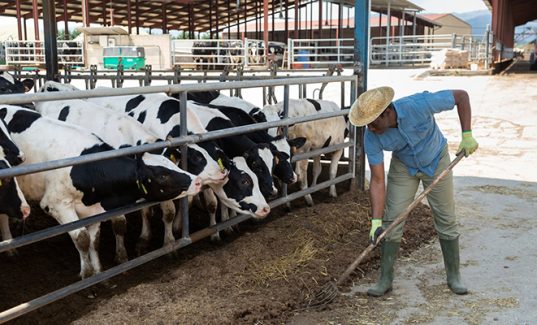RED DEER — Crossbreeding dairy cows may not fit everyone’s program, but it is one way to return vigour to a herd.
Studies from Northern Ireland and California show crossbred cows live longer with fewer fertility and lameness problems.
“These cows might not look as nice as what we are used to looking at, and they mightn’t produce as well on a given lactation stage, but when we talk about the overall profitability, I think we would be more open to the idea,” said Frank Buckley of Northern Ireland’s agriculture and food development authority.
“Crossbreeding gives a higher profitable return than either of the two purebreds,” he told the Western Dairy Seminar held in Red Deer March 11-14.
“The first cross is a very favourable animal.”
Canada focuses on production from a largely Holstein herd, but producers should look at the high replacement rate of nearly 50 percent every year.
The average Holstein lasts 2.5 lactations in Canada, while other breeds tend to have better longevity.
“If we go over 20 percent, we say there is something wrong,” he said.
More mature cows in the barn could save money because they are more productive and it won’t be necessary to raise a large number of replacement heifers each year.
Crossbreeding introduces more favourable genes from another breed, which is called hybrid vigour.
“The more genetically diverse the breeds are, the more genetically unrelated they are, the more hybrid vigour,” he said.
Crossbreeding is common in New Zealand and more crossbred bulls are used. The cows also live longer.
“In New Zealand, hybrid vigour is responsible for cows surviving one lactation more,” he said.
“That is a significant benefit.”
Mixing three breeds together, such as Holstein, Jersey and Brown Swiss, maintains or improves fertility, but that plan may reduce milk output because there is less Holstein in the mix.
Research at Teagasc Moorepark, an agricultural facility in Ireland, evaluated breeds and worked with 50 commercial herds. Breeds such as Montebeliarde, Norwegian Red, Normande and Jersey were crossed with Holsteins.
Norwegian Reds and Holsteins were the most favourable cross for Irish conditions.
“The crossbreds were $250 more profitable in our system,” Buckley said.
The cattle were moderate in size and added fertility with more pregnancies and shorter calving intervals.
Jersey-Holstein crosses produced less milk but it was richer with more butter fat content. They also had better feet, so lameness problems were lessened.
U.S. researchers have crossbred Holsteins with Normande, Montbeliarde, Swedish Red, Norwegian Red and Jersey animals, resulting in fewer open days and improved survival rates compared to pure Holsteins with little loss of production. Montbeliarde and Scandinavian Red crossbred cows were more profitable than purebred Holsteins.
All research found that crossbreeding did not cure poor management decisions. The farmers who were most successful with straight bred cattle were often also the best at crossbreeding.
Buckley said it is important to use the best bulls of each breed to get the best results. As well, such a change to breeding plans is a big commitment.
“There is no point in using the alternative breeds on a quarter or 10 percent of your herd,” he said.
“You must go the whole way to have an impact, otherwise it is a waste of time.”
Source The Western Producer




